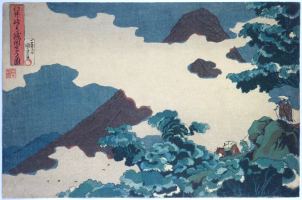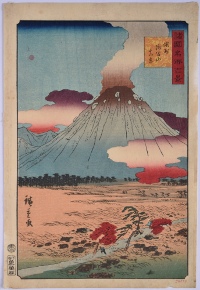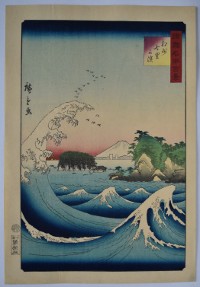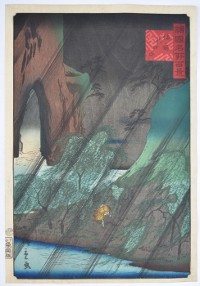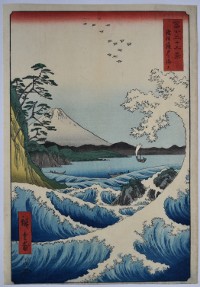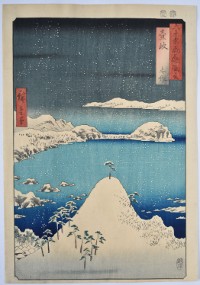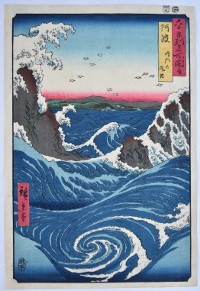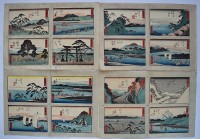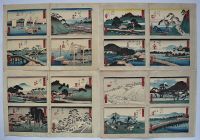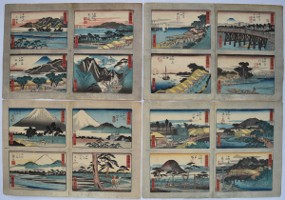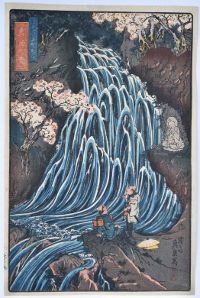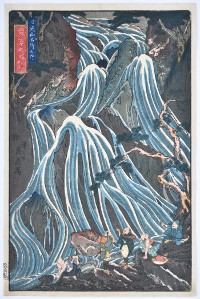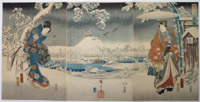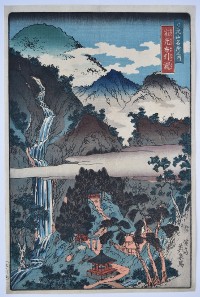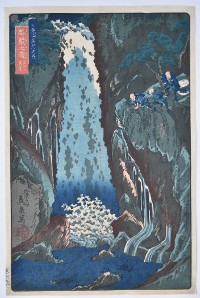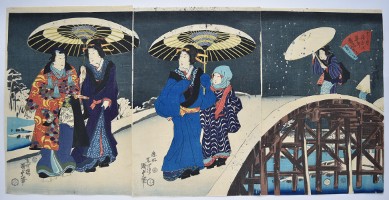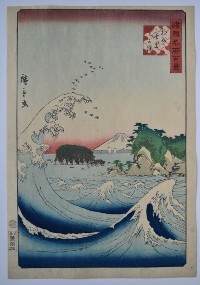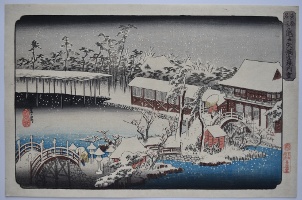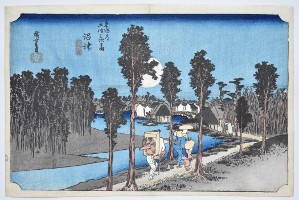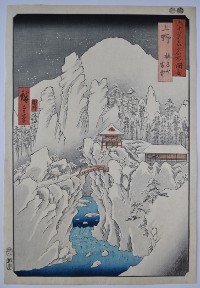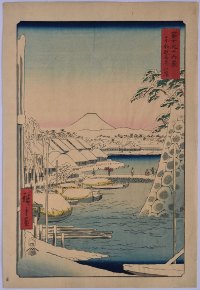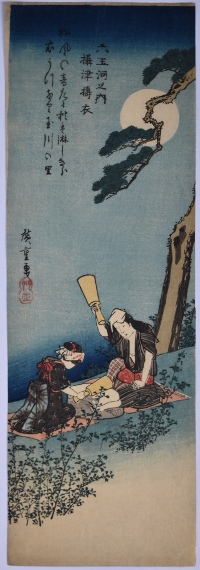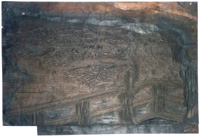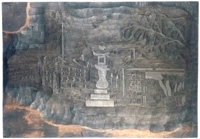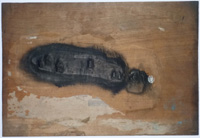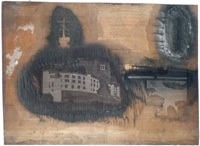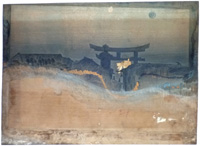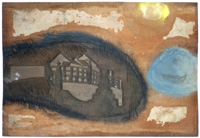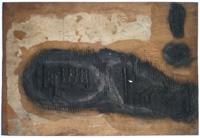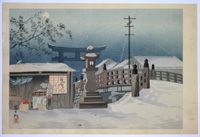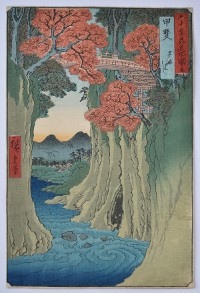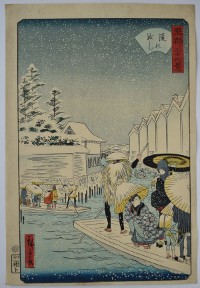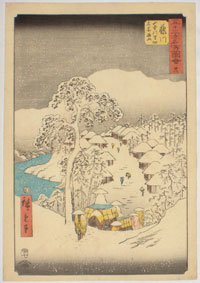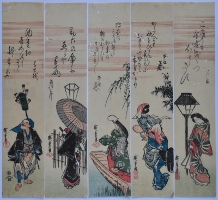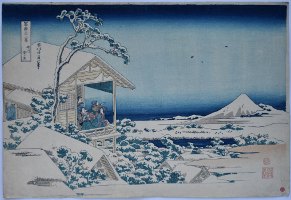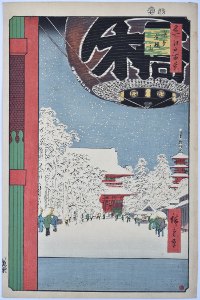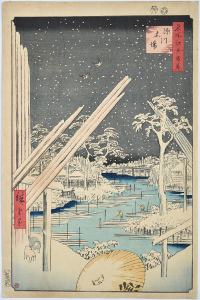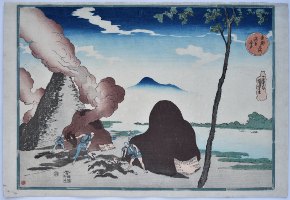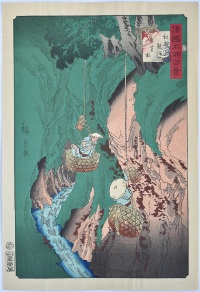/category/landscapes/page/5/
Utagawa KUNIYOSHI (1797-1861)
Click here to view image full size.
Travellers viewing Mount Asama. Usui-toge yori Asama o miru zu, “A View of Mount Asama from Usui Pass.” From Kuniyoshi’s best landscape set. Of the utmost rarity with most extant impressions differing. This and the impression in the Museum of Fine Arts, Boston, are similar, without the smoke coming from the cone of Asama (the most active volcano on Honshu). Other impressions are in: The British Museum, 1948, 0410, 0. 108, which has gradation up the left side of the mountain; the Metropolitan Museum of Art, JP 1424, with gradation down from the summit; and Worcester Art Museum which is similar to the Mets, 1901.692. Published by Yamaguchiya Tobei, c 1836. I have only had one other impression in over forty-five years of dealing.
Very good impression, colour and condition. Signed Ichiyusai Kuniyoshi ga.
Status: Sold
Ichiyusai HIROSHIGE II (1829-1869)
Click here to view image full size.
A view of a smoking Mt Asama, Shinano Province from Shokoku meisho hyakkei, the ‘One Hundred Views of Famous Places in the Provinces’. Published by Uoei, Sheep 9 ( 1859 ).
Very good impression, colour and, apart from one small spot, very good condition. Signed Hiroshige ga.
Status: Sold
Utagawa HIROSHIGE II (1826-1869)
Click here to view image full size.
The Seven Ri Beach, Sagami Province, Sagami Shichirigahama, from an unfinished set Shokoku meisho hyakkei, “One Hundred Views of Famous Places in the Provinces.” Published by Uoya Eikichi between 1859 and 1861 (this being 1859). A popular area during Edo times as one could get a view of both Mount Fuji and Enoshima at the same time. The Ri in the title is an old unit of measurement. This design obviously bears comparison with both Hiroshige’s “wave” from the Thirty-Six Views of Fuji and Hokusai’s “wave” from a series with same title.
Superb impression of the first edition. (Extremely rare in this state.) Very fine colour and condition. Signed Hiroshige ga.
Status: Sold
Utagawa HIROSHIGE II (1826-1869)
Click here to view image full size.
The Dragon’s Maw Mountain, Bizen Province, Bizen tatsu-no-kuchi yama from an unfinished set Shokoku meisho hyakkei, “One Hundred Views of Famous Places in the Provinces.” Published by Uoya Eikichi between 1859 and 1861 (this being 1860). Shows a lone figure battling a heavy rainstorm in a steep-sided canyon.
Superb impression and colour. The extremely rare first edition with gradation on the figure’s straw cape and bokashi clouds. The best quality red pigment is used and double-printed in the cartouches. Fine condition. A masterpiece in this state. Signed Hiroshige ga.
Status: Sold
Utagawa HIROSHIGE (1797-1858)
Click here to view image full size.
Suruga Satta no kaijo, “The Sea at Satta, Suruga Province” from the set Fuji sanjurokkei, “The Thirty-Six Views of Fuji.” The series published by Tsutaya Kichizo, 1858. Shows the coast of Oyashirazu at Satta on the west side of Suruga Bay with a large wave about to break on the coast. The spume from the wave is supposed to turn into chidori and they can be seen here flying away. This area is on the Tokaido Road between Edo and Kyoto and, previous to 1655, travellers had to circumvent the cliffs – some of which are 300-400 metres tall – by way of the base, near the sea. However, in that year, to facilitate the journey a pass was cut in the rock above the cliff. The best design from the set. Early impressions of this set were particularly well printed as a tribute to Hiroshige’s life. Late editions have a signature label printed in yellow instead of red.
Fine impression and colour. Trimmed close at bottom left, otherwise fine condition. Signed Hiroshige ga.
Status: Sold
Utagawa HIROSHIGE (1797-1858)
Click here to view image full size.
A fine snow scene: Iki Shisaku, “Shisaku in Iki Province” from a set of sixty-nine prints plus title page Rokuju yoshu meisho zue, “Famous Places in the Sixty-Odd Provinces.” Published by Koshimuraya Heisuke, 1853-1856 (this being 1856). This far-flung region of Japan at the southern tip of the main group of islands is evocatively captured here.
Superb impression of the very rare first edition with variegated cartouche and bokashi clouds. Fine colour and condition. Signed Hiroshige ga.
Status: Sold
Utagawa HIROSHIGE (1797-1858)
Click here to view image full size.
Awa Naruto no fuha, “Angry Seas at Naruto, Awa” from a set of sixty-nine prints plus title page Rokuju yoshu meisho zue, “Famous Places in the Sixty-Odd Provinces.” Published by Koshimuraya Heisuke, 1853-1856 (this being 1855). The most famous design from the set. This area of sea between the islands of Shikoku and Honshu , where the waters of the Inland Sea and Pacific Ocean meet, is famous for its whirlpools. Hiroshige returned to this theme in a triptych setsu-getsu-ka set where the whirlpools represent “Flower.”
Very good impression, colour and condition. Signed Hiroshige ga.
Status: Sold
Utagawa HIROSHIGE (1797-1858)
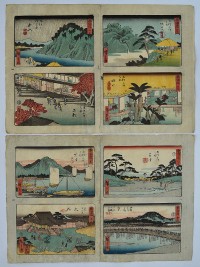
Click here to view image full size.
A complete Tokaido set of 56 prints printed four-to-a-sheet on fourteen sheets, uncut. Each sheet has an indication of where it is to be cut. Published by Aritaya Seiemon, 1845. Extremely rare complete.
Fine impressions and colour. Centre folds and some soil at bottom on some sheets. One sheet restored, but overall in good condition. Each design signed Hiroshige ga.
Status: Sold
Keisai EISEN (1790-1848)
Click here to view image full size.
Although Eisen produced a considerable number of bijin-e and surimono, his best work was in landscape design and amongst these the finest are this set and a few designs for the Kisokaido. Kirifuri-no-taki, santaki no sono ikkei, “Kirifuri Waterfall – View of One of the Three Falls.” From a set Nikkozan meisho no uchi, “Celebrated Views in the Nikko Mountains.” The set of eight prints published by Yamamotoya Heikichi, c. mid 1840s. The set obviously invites comparison with Hokusai’s earlier waterfall set but they are chunkier, more prosaic and with the movement of the water more defined. Shows travellers admiring the fall. A stone Jizo figure on the right (guardian of travellers). Rare.
Fine impression. (There do not appear to be late impressions of this set – presumably it was not popular at the time.) Fine colour. Imperceptible fold, otherwise fine condition. Signed Eisen utsusu.
Status: Sold
Keisai EISEN (1790-1848)
Click here to view image full size.
Although Eisen produced a considerable number of bijin-e and surimono, his best work was in landscape design and amongst these the finest are this set and a few designs for the Kisokaido. Somen-no-taki, “Somen Waterfall.” From a set Nikkozan meisho no uchi, “Celebrated Views in the Nikko Mountains.” The set of eight prints published by Yamamotoya Heikichi, c. mid 1840s. The set obviously invites comparison with Hokusai’s earlier waterfall set but they are chunkier, more prosaic and with the movement of the water more defined. Shows travellers at the base of the fall.
Fine impression. (There do not appear to be late impressions of this set – presumably it was not popular at the time.) Fine colour. Imperceptible fold, otherwise fine condition. Signed Eisen utsusu.
Status: Sold
Ichiryusai HIROSHIGE (1797-1858)
Click here to view image full size.
The finest design from all the Hiroshige/Kunisada collaborations with the superb snowscape designed by Hiroshige, and the figures by Kunisada. From a triptych series Furyu Genji, “Elegant Genji.” The Tale of Genji was written by Shikibu Murasaki and published in 1021 and follows the life of this multi-endowed character. Published in 1858 by Isaya Kanekichi.
Fine impression and colour. Extensive splashed gofun ( oxidised ). Very good condition. Signed Hiroshige ga and Kunisada ga.
Status: Sold
Keisai EISEN (1790-1848)
Click here to view image full size.
Jakko Nunobiki no taki, “Jakko [Temple] Nunobiki Waterfall” from a set of eight prints Nikkosan meisho no uchi, “Celebrated Views in the Nikko Mountains.” Published by Yamamotoya Heikichi c. 1844. Obviously inspired by Hokusai’s set of waterfalls. See: The Japanese Print: A New Approach, J. Hillier, Bell & Son, 1960, Chapter XVI, where Jack Hillier discusses Eisen and his landscapes and considers this set “… is perhaps the crowning achievement of his career as a designer of landscape-prints.” Extremely rare.
Very fine impression. (I have only seen early impressions of this set – perhaps it was not popular at the time.) Fine colour. Extremely slight vertical fold, otherwise fine condition. Signed Keisai Eisen utsusu.
Status: Sold
Keisai EISEN (1790-1848)
Click here to view image full size.
Kegon no taki, santaki no sono ikkei, “Kegon Falls, One of the Three Waterfalls” from a set of eight prints Nikkosan meisho no uchi, “Celebrated Views in the Nikko Mountains.” Published by Yamamotoya Heikichi c. 1844. Obviously inspired by Hokusai’s set of waterfalls. See: The Japanese Print: A New Approach, J. Hillier, Bell & Son, 1960, Chapter XVI, where Jack Hillier discusses Eisen and his landscapes and considers this set “… is perhaps the crowning achievement of his career as a designer of landscape-prints.” Extremely rare.
Very fine impression. (I have only seen early impressions of this set – perhaps it was not popular at the time.) Fine colour. Extremely slight vertical fold, otherwise fine condition. Signed Keisai Eisen utsusu.
Status: Sold
Utagawa KUNISADA II (1823-1880)
Click here to view image full size.
A snow scene showing Prince Genji and attendants on Sugatami Bridge from a set of twelve months: Junikagetsu Genji no Sugatami. This being the eleventh month. Published by Yamashiroya Jinbei, 1867.
Fine impression, colour and condition with extensive splashed gofun. Signed Kochoro Kunisada hitsu
Status: Sold
Ichiryusai HIROSHIGE II (1829-1869)
Click here to view image full size.
Soshu Shichirigahama, the “Seven Ri Beach” near Kamakura, Kanagawa Prefecture. From the set Shokoku meisho hyakkei, “The One Hundred Views of Famous Places in the Provinces.” From the beach one gets a clear view of Fuji and Enoshima Island – both framed by a giant wave. The set (of which only 80 are known) was published by Uoya Eikichi, 1859-61 (this being 1859). Hiroshige’s foremost pupil. He was called Shigenobu until assuming the name Hiroshige II on Hiroshige’s death. Married his daughter.
Very good impression and colour. Very slight stain in cartouche, otherwise very good condition. Sugned Hiroshige ga.
Status: Sold
Ichiryusai HIROSHIGE (1797-1858)
Click here to view image full size.
Kameido Tenmangu keidai no yuki, “The Compound of the Tenman Shrine at Kameido in Snow.” From a set of twenty-one prints Toto meisho, “Famous Views in the Eastern Capital” published by Sanoya Kihei, c. 1834-5. The series was extended to fifty-five in c.1839-42. One of the most famous places in Edo. Known for its pergola, two drum bridges, koi ponds and the wisteria which flowered in the fifth month. The main shrine is dedicated to the memory of Sugawara no Michizane (Tenjin), the father of Japanese learning and built in 1662. The design comes in various states: Late editions have a black sky and the red publisher’s seal on right margin, is replaced with an abbreviated Sanoki seal in black. Even later editions show a slipping plug becoming evident on the edge of the water, centre left.
Very good impression, colour and condition. Signed Hiroshige ga.
Status: Sold
Ichiryusai HIROSHIGE (1797-1858)
Click here to view image full size.
Numazu, Hikure, “Yellow Dusk” from Tokaido gojusan tsugi, “The Fifty-three Stations of the Tokaido.” The set of fifty-five prints was published jointly by Hoeido and Senkakudo in 1834. Shows travellers about to enter the village of Numazu beneath the huge orb of the moon. On each side are dark pines, and this station is famous for its forest which stretches along the seashore. One of the travellers is carrying a red tengu mask on his back, the mark of a pilgrim to the Shinto shrine of Kompira.
Very good impression and colour. Imperceptible centre fold and minor repaired wormage on bottom margin, otherwise very good condition. Signed Hiroshige ga.
Status: Sold
Ichiryusai HIROSHIGE (1797-1858)
Click here to view image full size.
Kozuke, Harunasan setchu, “Kozuke [Province], Mount Haruna Under Snow.” From the set of sixty-nine prints, Rokuju-yoshu meisho zue, “Views of Famous Places in the Sixty-odd Provinces.” Published 1856 by Koshihei, although sealed between 1853-56 (this being 1853). A red bridge spans a gorge with precipitous cliffs and a fast flowing river. Fantastic crags point upwards into the sky. In the distance is Mount Haruna, a sleeping volcano.
Fine, early impression. Fine colour and condition. Signed Hiroshige ga.
Status: Sold
Ichiryusai HIROSHIGE (1797-1858)
Click here to view image full size.
Sukiya embankment in snow, Toto Sukiya-gashi, from Fuji sanjurokkei, the “Thirty-six Views of Fuji.” The set published by Tsutaya Kichizo, 1858. The rampart on the inner side of the moat of Edo Castle on the right. Figures cross a bridge leading to Sukiya Gate. In the distance the long outer walls of the main residence of the Nabeshima Clan of Saga. Fuji on the horizon.
Fine impression and colour. Imperceptible centre fold, otherwise very good condition. Signed Hiroshige ga.
Status: Sold
Ichiryusai HIROSHIGE (1797-1858)
Click here to view image full size.
Fulling cloth beneath a full moon. Toi Tama-qawa in Settsu Province from the set Six Tama Rivers. One of the two best designs from the set. Published circa early 1830s.
Fine impression and colour. Minor repair extreme top edge, otherwise fine condition. Signed Hiroshige ga. A beautiful print.
Status: Sold
Tomikichiro TOKURIKI (1902-2000)
Click here to view image full size.
The original keyblock woodblock for print 20, Distant View of Fuji from Ise Asama Mountain from The Thirty-six Views of Fuji, published by Uchida Bijutsu Shoten, 1939-40. Sold together with the annotated finished print. The reverse of the block has another unidentified image. Block size 11.5 x 16.75 in; 29 x 42.8 cms. Block sold “as is” and the print has some minor damage.
Status: Sold
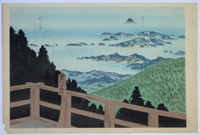
Click here to view image full size.
Tomikichiro TOKURIKI (1902-2000)
Click here to view image full size.
A complete set of 5 double-sided original woodblocks comprising the keyblock and 9 colour blocks. Sold together with the finished print. Although late, it’s very rare to find complete sets of blocks and shows clearly how the prints were produced. Some of the blocks retain the keyblock proofs glued to them. For print 11, Kameyama Shrine in Kishu from a set of 50 prints of scenes of sacred places and historic landmarks. Published by Uchida Bijutsu Shoten, 1941. The average size of blocks is 11.75 x 17 in; 30 x 43 cms. All blocks sold “as is.” The print is in good condition.
Status: Sold
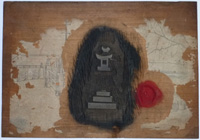
Click here to view image full size.
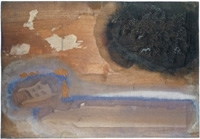
Click here to view image full size.
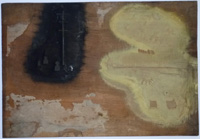
Click here to view image full size.
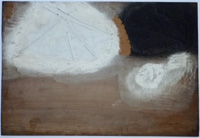
Click here to view image full size.
Yashima GAKUTEI (1786?-1868)
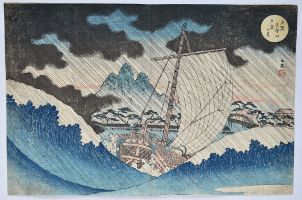
Click here to view image full size.
A sailing junk caught in stormy seas, driving rain, and under a threatening sky. The masterpiece from a set of six prints issued in album form with title Naniwa meisho, Tempozan shokei ichiran, “A Famous Place in Osaka, Selected Views of Mount Tempo.” Published in Osaka, 1834, by Shioya Kisuke. In the circular cartouche: Osaka Tempozan yudachi no kei, “View of a Storm at Tempozan, Osaka.”Gakutei is best known for his many surimono. He was also a kyoka poet and painter. Unfortunately he produced few landscapes. Other impressions illustrated in Michener, Japanese Prints, no. 198; Mellor sale catalogue, Sotheby, July 1963, pl. XXXI; and Grabhorn, Landscape Prints of Old Japan, pl. 30. SC I/344. One of the great 19th century landscapes.
Fine impression. Very good colour. Slight trimming at bottom and backed centre fold (as usual as it was published in folding album form), otherwise good condition. Signed Gogaku with seal Go.
Status: Sold
Ichiryusai HIROSHIGE (1797-1858)
Click here to view image full size.
The cantilevered Monkey Bridge from Rokujuyoshu meisho zue, “Famous Views in the Sixty-odd Provinces.” Published by Koshimuraya Heisuke 1853-6 (this being 1853). This bridge – one of the three most famous bridges in Japan – is situated in Otsuki and purports to be 1300 years old (albeit rebuilt many times).
Fine impression of the first edition. Fine colour. Trimmed close, otherwise very good condition. Signed Hiroshige ga.
Status: Sold
Utagawa HIROSHIGE II (1826-1869)
Click here to view image full size.
Yoroi no watashi, “Yoroi Ferry” from the set Toto sanjurokkei, “Thirty-six Views of Edo.” Published by Ai-To, 1862. Shows the laden ferry crossing in heavy snow. The Koami-cho warehouses on the right.
Fine impression of the first edition. Fine colour and condition. Signed Hiroshige ga.
Status: Sold
Ichiryusai HIROSHIGE (1797-1858)
Click here to view image full size.
A rare triptych showing fireworks over Ryogoku bridge with numerous pleasure boats negotiating the huge trestles of the bridge. A fine design published 1847 – 50 by Sanoki.
Very fine impression. Pristine colour and condition. Totally untrimmed and with deluxe double-printed red. Signed Hiroshige ga.
Status: Sold
Ichiryusai HIROSHIGE (1797-1858)
Click here to view image full size.
Fujikawa from the so-called “Upright Tokaido.” One of the two snow scenes from the set. Shows travelers coming and going at the edge of the village. Published by Tsutaya, Hare 7, 1855.
Very good impression with woodgrain evident in the sky. Very good condition with full margins. Signed Hiroshige ga.
Status: Sold
Utagawa HIROSHIGE (1797-1858)
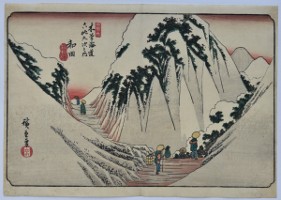
Click here to view image full size.
Shows station Wada in heavy snow from Kisokaido rokujukyutsugi no uchi. The set of seventy prints was started by Eisen and published by Hoeido in 1835, but in 1837 Hiroshige took over and completed the series with the publisher Iseya Rihei (Kinjudo). This high pass (1651 metres) was a difficult part of the journey.
Fine early impression before the break in the key block to the left and beneath the publisher’s gourd seal. Fine colour. Slight centre fold, otherwise very good condition. Signed Hiroshige ga.
Status: Sold
Utagawa TOYOHARU (1735-1814)
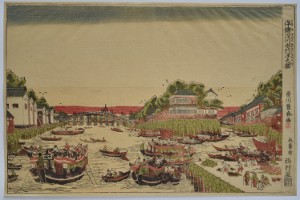
Click here to view image full size.
The founder of the Utagawa school who had, amongst others, Toyohiro and Toyokuni as his pupils. Although not the first to use western conventions of linear perspective, he was the first to employ them extensively and in full colour and had obviously studied engravings from Holland, Germany and Italy -particularly prints of Venice after Canaletto. Uki-e Fukagawa Eitai suzumi no zu, “Perspective Picture: A View Enjoying the Cool Near Eitai Bridge, Fukagawa.” Shows the Sumida River busy with boats; Eitai Bridge in the distance to the left and beyond the masts of vessels moored at Tsukudajima. (The Eitai Bridge was to collapse in 1807 killing anything from 500-1500 people.) To the right the then newly built neighbourhood of Nakazu. The water on the right is the Hakozaki canal. Published by Eijudo, c 1771. Provenance: Ex Hayashi collection, seal in right border. Extremely rare.
Fine impression and colour with the blue at the top intact which is very rare. In exceptional condition. Signed Utagawa Toyoharu ga.
Status: Sold
Utagawa HIROSHIGE III (1842-1894)
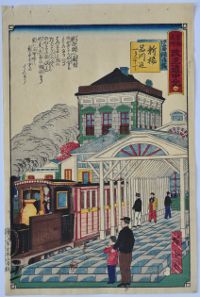
Click here to view image full size.
Shinbashi station from a set of prints Tokai meisho kaisei dochu-ki, “Newly Edited Travel Stories of Famous Places of the Tokaido.” Published by Shimizuya Naojiro, 1875. The station was opened in 1872.
Very good impression and colour. Binding holes in top border, otherwise very good condition. Signed Hiroshige ga.
Status: Sold
Utagawa HIROSHIGE III (1842-1894)
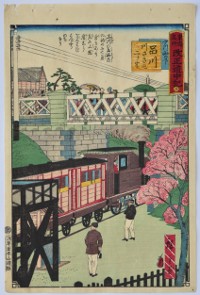
Click here to view image full size.
A train passing beneath a bridge at Shinagawa from a set of prints Tokai meisho kaisei dochu-ki, “Newly Edited Travel Stories of Famous Places of the Tokaido.” Published by Shimizuya Naojiro, 1875
Very good impression and colour. Binding holes in top border, otherwise very good condition. Signed Hiroshige ga.
Status: Sold
Utagawa HIROSHIGE III (1842-1894)
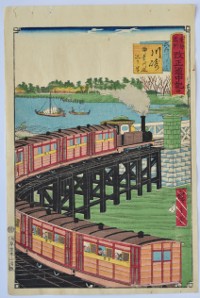
Click here to view image full size.
A train at Kawasaki from a set of prints Tokai meisho kaisei dochu-ki, “Newly Edited Travel Stories of Famous Places of the Tokaido.” Published by Shimizuya Naojiro, 1875.
Very good impression and colour. Binding holes in top border, otherwise very good condition. Signed Hiroshige ga.
Status: Sold
Utagawa HIROSHIGE III (1842-1894)
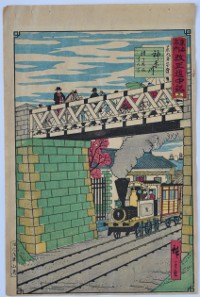
Click here to view image full size.
A train at Kanagawa station, Yokohama from a set of prints Tokai meisho kaisei dochu-ki, “Newly Edited Travel Stories of Famous Places of the Tokaido.” Published by Shimizuya Naojiro, 1875.
Very good impression and colour. Binding holes in top border, otherwise very good condition. Signed Hiroshige ga.
Status: Sold
Utagawa HIROSHIGE (1797-1858) and Utagawa KUNISADA (1786-1864)
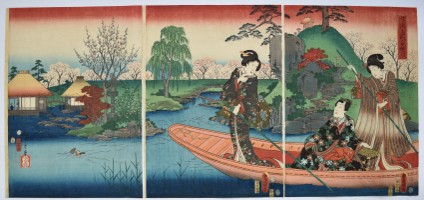
Click here to view image full size.
Prince Genji being poled in a punt on a lake. From a set of such triptychs published by Iseya Kanekichi in 1853. Furyu Genji fune asobi, “Fashionable Genji Enjoying a Pleasure Boat.”
Very fine impression and colour. Slightly trimmed at bottom, otherwise fine condition. Signed Hiroshige ga and Toyokuni ga.
Status: Sold
Ichiryusai HIROSHIGE (1797-1858)
Click here to view image full size.
Five ko-tanzaku ( an oban cut into three ) prints of various subjects ( Bon odori,
Sukeroku, Hatchitataki, etc ) from an excessively rare set of 15 such prints from 5
sheets. I have located only one other group ( of six designs duplicating three offered
here ). Published by Matsumura Yahei c late 1830’s.
Fine impressions and colour. Some wormage, otherwise very good condition. Signed
Hiroshige ga on each.
Status: Sold
Katsushika HOKUSAI (1760-1849)
Click here to view image full size.
Koishikawa yuki no ashita, “Snowy Morning at Koishikawa” from Hokusai’s most celebrated set: Fugaku sanjurokkei, the “Thirty-six Views of Mount Fuji.” The set of 46 prints published by Eijudo, c. 1830-32. Shows a party at a teahouse, at left, admiring the view of Fuji. The only snow scene from the set. Provenance: Ex Le Veel collection, sold by Ader Picard Tajan, Paris, 2nd sale, 24/10/1980, lot 76, p. 36.
Exceptionally early impression (blue outline). Fine colour and, apart from slight vertical crease, fine condition. Very full size with extra paper top and right. This design usually has a clear sky with blue gradation at top and horizon. This state with a subtly graded blue sky appears to be the earliest version (with other similar impressions in the BM [1927.0613.0.13] and MET [JP1330]). Not only does it better convey the wintry conditions but Eijudo was probably also conscious of saving money on this expensive pigment on later editions. The finest example to come onto the market for many years. Signed Zen Hokusai Iitsu hitsu.
Status: Sold
Ichiryusai HIROSHIGE (1797-1858)
Click here to view image full size.
Asakusa Kinryuzan, “Kinryuzan Temple at Asakusa” Meisho Edo hyakkei, “The Hundred Views of Famous Places in Edo.” The view shown by Hiroshige is through the Kaminarimon gateway with the large hanging lantern after a heavy snowfall. The great temple, which still stands, was in the northern part of Edo, not far from the Yoshiwara. Published by Uoya Eikichi who published the set between 1856 – 1858 (this being 1856). There are 118 prints in the set plus a replacement design by Hiroshige II. This is one of Hiroshige’s best known designs.
Very good impression, colour and condition. Grain showing on the red wooden post at left and the lines still crisp. On later editions the red and green pigment gets cruder and the sky darker. And even later a slipping plug becomes evident in the blue area at bottom, below the black line at left. Signed Hiroshige ga.
Status: Sold
Ichiryusai HIROSHIGE (1797-1858)
Click here to view image full size.
The Lumberyard, Fukagawa, from Meisho Edo hyakkei, “The Hundred Views of Famous Places in Edo.” Shows snow falling on the timber yards lining a river. An umbrella in the foreground is inscribed Uo, “Fish” – a reference to the publisher Uoya Eikichi who published the set between 1856 – 1858 (this being 1856). There are 118 prints in the set plus a replacement design by Hiroshige II. A large supply of timber was needed for the world’s largest wooden city. However, in 1641 a fire destroyed not only houses but the lumber which was then stored in a central area causing the government to move the yards to Fukagawa.
Very good impression, still with the lighter sky: Late editions have a black sky. Very good colour and condition. Signed Hiroshige ga.
Status: Sold
Utagawa KUNIYOSHI (1797-1861)
Click here to view image full size.
Asakusa Imado from a Toto meisho set of ten prints published c. 1834. Shows three men stoking the ceramic tile kilns at Imado on the bank of the Sumida river. Mount Tsukuba can be seen in the distance. The kilns were fuelled by pine needles, a stack of which can be seen on the left. This set, and other landscapes by Kuniyoshi, are characterised by strong western-style elements – shadows and clouds derived from viewing imported prints and books from Europe. Published by Kagaya Kichibei, c. 1834. Provenance: Ex B.W.Robinson collection (purchased privately). Very rare.
Fine impression, colour and condition. The green bamboo border intact. The set is well known for having this border trimmed off, partially or completely. Signed Ichiyusai Kuniyoshi ga.
Status: Sold
Utagawa HIROSHIGE II (1826-1869)
Click here to view image full size.
Gathering iwatake, rock tripe or rock mushrooms in Kii Province. The common name for various edible lichens that grow on cliffs. The gatherers used precarious baskets that were hauled up and down the cliff face to collect them. Kishu Kumano iwatake tori from Shokoku meisho hyakkei, “One Hundred Views of Famous Places in the Provinces.” Published by Uoyei 1859-1861 (this being 1860). A fascinating print.
Very fine impression of the first edition. Fine colour and condition. Signed Hiroshige ga.
Status: Sold
